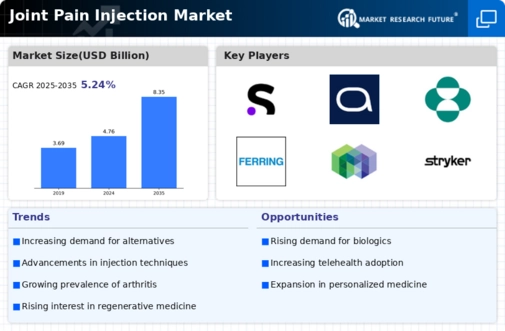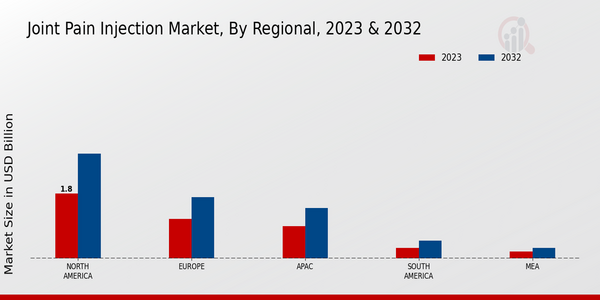Market Growth Projections
The Global Joint Pain Injection Market Industry is projected to experience substantial growth over the next decade. With a market value anticipated to reach 4.76 USD Billion in 2024 and further expand to 8.35 USD Billion by 2035, the industry is set to witness a compound annual growth rate of 5.24% from 2025 to 2035. This growth trajectory indicates a robust demand for joint pain management solutions, driven by various factors including technological advancements, increasing prevalence of joint disorders, and rising patient awareness. The market dynamics suggest a promising future for joint pain injection therapies.
Growing Awareness and Education
There is a notable increase in awareness and education regarding joint pain management, which is positively influencing the Global Joint Pain Injection Market Industry. Healthcare campaigns and patient education initiatives are informing individuals about the benefits of joint injections, including corticosteroids and hyaluronic acid. This heightened awareness encourages patients to seek treatment sooner, thereby increasing the demand for these injections. As more individuals recognize the potential for improved quality of life through effective pain management, the market is expected to expand, with projections indicating a market value of 8.35 USD Billion by 2035.
Advancements in Injection Techniques
Innovations in injection techniques are enhancing the efficacy and safety of joint pain treatments, thereby propelling the Global Joint Pain Injection Market Industry. Techniques such as ultrasound-guided injections and intra-articular therapies are becoming more prevalent, allowing for precise delivery of medications directly into the affected joints. These advancements not only improve patient outcomes but also reduce the risk of complications associated with traditional methods. As healthcare providers adopt these new techniques, the market is likely to see increased adoption rates, contributing to a projected compound annual growth rate of 5.24% from 2025 to 2035.
Rising Prevalence of Joint Disorders
The Global Joint Pain Injection Market Industry is experiencing growth due to the increasing prevalence of joint disorders, such as osteoarthritis and rheumatoid arthritis. According to data, millions of individuals worldwide suffer from these conditions, leading to a higher demand for effective treatment options. The aging population, particularly in developed nations, contributes significantly to this trend. As the global population ages, the incidence of joint-related issues is expected to rise, thereby driving the market for joint pain injections. This growing need for management solutions is projected to elevate the market value to 4.76 USD Billion in 2024.
Rising Demand for Minimally Invasive Procedures
The trend towards minimally invasive procedures is significantly influencing the Global Joint Pain Injection Market Industry. Patients increasingly prefer treatments that involve less recovery time and lower risks compared to traditional surgical options. Joint injections, being minimally invasive, align with this preference, offering effective pain relief with reduced downtime. This shift in patient expectations is driving healthcare providers to adopt injection therapies more widely. As the demand for such procedures continues to rise, the market is likely to experience robust growth, reflecting changing patient attitudes towards joint pain management.
Increased Investment in Healthcare Infrastructure
Investment in healthcare infrastructure is a critical driver for the Global Joint Pain Injection Market Industry. Governments and private sectors are allocating resources to enhance healthcare facilities and improve access to advanced treatment options. This investment is particularly evident in emerging economies, where healthcare systems are evolving to meet the growing demand for joint pain management solutions. Enhanced facilities and availability of trained professionals facilitate the adoption of joint pain injections, thereby supporting market growth. As healthcare infrastructure continues to develop, the market is poised for sustained expansion.














